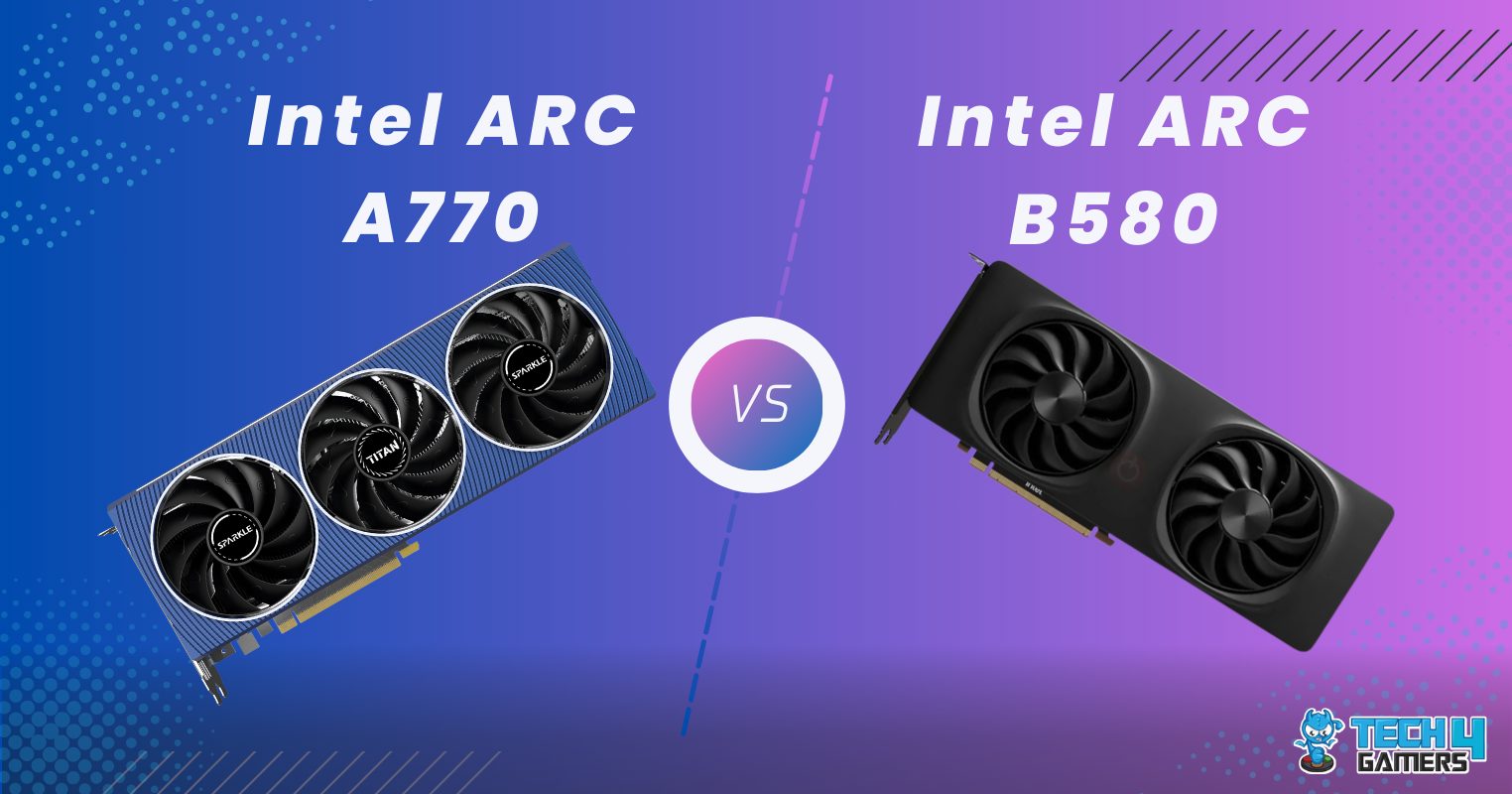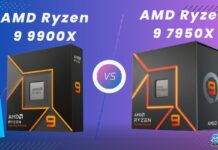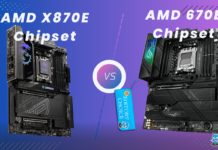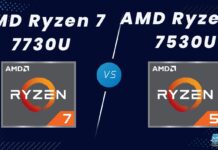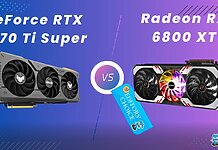I had the opportunity to explore the Nvidia GeForce RTX 3080 12GB, a lesser-known variant compared to the familiar 10GB model. Surprisingly, the 12GB version offers improved performance. In this article, I’ll delve into the distinctions between the RTX 3080 (10GB) vs RTX 3080 (12GB) to provide a comprehensive comparison and help you make an informed choice.
Key Takeaways
- According to my personal experience, I’ve observed that the RTX 3080 10GB and 12GB variants come with distinct specifications, with the 12GB version offering a performance advantage of around 6.9% over the RTX 3080 10GB.
- When it comes to temperature management, the RTX 3080 12GB maintains a 0.2% cooler profile compared to the RTX 3080 10GB, a minor difference I’ve observed. However, it also consumes more power, around 18.1%.
- Pricing-wise, the RTX 3080 12GB tends to be $100 to $200 more expensive than its 10GB counterpart, with water-cooled variants adding an additional $200 premium over the RTX 3080 12GB, based on my findings.
Comparison Table
| Technical Specs | GeForce RTX 3080 (10GB) | GeForce RTX 3080 (12GB) |
| GPU Name | GA102 | GA102 |
| Architecture | Ampere | Ampere |
| Transistors | 28,300 million | 28,300 million |
| Shading Units | 8704 | 8960 |
| Tensor Cores | 272 | 280 |
| RT Cores | 68 | 70 |
| TMUs | 272 | 272 |
| ROPs | 96 | 96 |
| L1 Cache | 128 KB (per SM) | 128 KB per Array |
| L2 Cache | 5 MB | 5 MB |
| Memory Bus Width | 320 bit | 384 bit |
| Memory Bandwidth | 760.3 GB/s | 912.4 GB/s |
| Suggested PSU | 700W | 750W |
| Release Date | Sep 1st, 2020 | Jan 11th, 2022 |
| Approximated Price | 800 USD | 1000 USD |
| Best Variants | BEST RTX 3080 Cards |
Architectural Differences
- Process Node: In my analysis, both the RTX 3080 (10GB) and RTX 3080 (12GB) share an 8nm process node for their GPUs.
- Clock Speed: Examining clock speeds, I’ve observed that the RTX 3080 (10GB) features a base clock of 1440 MHz and a boost clock of 1710 MHz, while the RTX 3080 (12GB) boasts a base clock of 1260 MHz and the same boost clock of 1710 MHz.
- VRAM: When it comes to VRAM, the RTX 3080 (10GB) is equipped with 10GB of GDDR6X memory, whereas the RTX 3080 (12GB) boasts 12GB of GDDR6X VRAM.
- TDP: In terms of thermal design power (TDP), I’ve found that the RTX 3080 (10GB) has a 320W TDP, while the RTX 3080 (12GB) features a slightly higher TDP of 350W.
- Supported Technologies: Both the RTX 3080 (10GB) and RTX 3080 (12GB) support DLSS (Deep Learning Super Sampling), which enhances gaming performance through AI-driven upscaling, based on my observations.
Also Read: RTX 3080 Vs 3080 Ti
RTX 3080 (10GB) Vs RTX 3080 (12GB): Gaming Benchmarks
Benchmark tests are essential to assess the performance gap between graphics cards accurately. I’ve personally conducted tests on both the RTX 3080 10GB and RTX 3080 12GB, utilizing my robust i9-12900K processor and 16GB of RAM for a comprehensive evaluation.
Testing Rig
- OS: Windows 11
- CPU: Intel Core i7-13700K
- Motherboards: ASRock Z790 Taichi Lite Motherboard
- RAM: Kingston Fury Renegade RGB DDR5 32GB 7200MHz
- SSD: XPG GAMMIX S70 BLADE 2TB NVMe SSD
- PSU: Enermax Revolution D.F. X 1050W
- CPU Cooler: MSI MAG CORELIQUID E360 CPU Liquid Cooler
Red Dead Redemption 2
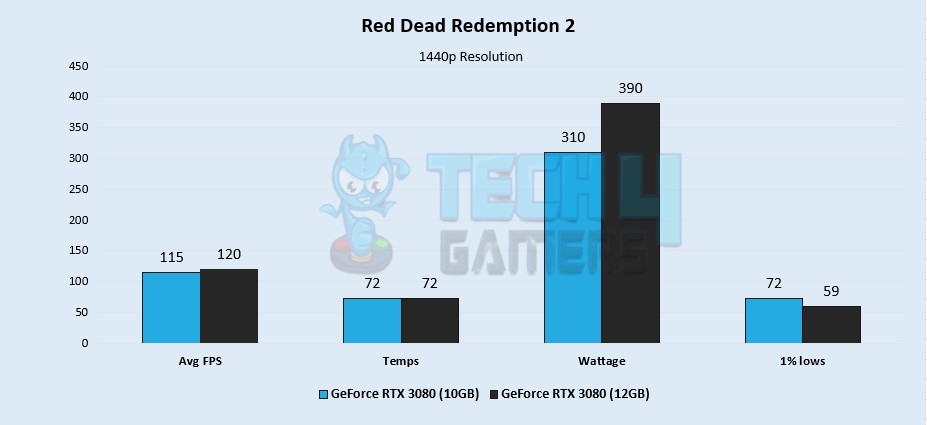
- In my tests at 1440p resolution, the RTX 3080 12GB showcased a 5 FPS advantage, with an average of 120 FPS compared to the 10GB version’s 115 FPS, reflecting consistent fluctuations.
- Impressively, temperatures reached only about 72°C for both graphics cards, although the 12GB version displayed more consistent values.
- In terms of power consumption, the 10GB model consumed approximately 310W, while the 12GB model exhibited significant oscillations, ranging from 379 to 401W, with an average consumption of 390W.
- Examining 1% lows, the RTX 3080 10GB maintained stability at 68-74 FPS, hovering around 72 FPS. In contrast, the 12GB variant exhibited larger fluctuations, ranging around 59 FPS.
Similar Comparisons: RTX 3080 Vs RX 6900 XT
Forza Horizon 5
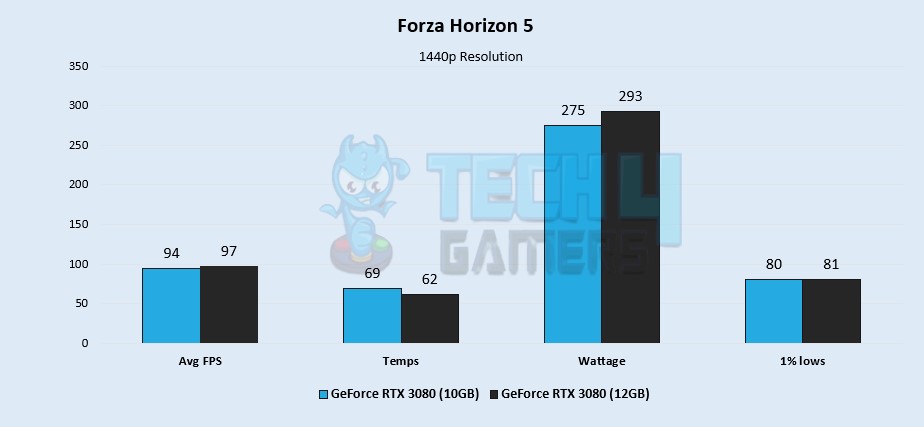
- While going over Forza Horizon 5, both GPUs delivered a solid performance with an average FPS exceeding 90. The margin between them was minimal, with the RTX 3080 10GB achieving an average of 94 FPS, while the RTX 3080 12GB reached 97 FPS.
- In terms of temperatures, I found that the RTX 3080 12GB demonstrated a slight decrease compared to the 10GB variant. While the 12GB version’s temperatures fluctuated from 59°C to 66°C, it predominantly operated at an average of 62°C. In contrast, the RTX 3080 10GB maintained a consistent temperature of 69°C.
- When considering power consumption, the RTX 3080 with lower VRAM consumed power ranging from 245W to 284W, with an average consumption of 275W. On the other hand, the 12GB model exhibited a minimum consumption of 253W and a maximum of 303W, with an average power consumption of 293W.
- The difference in average 1% lows was similarly slight in my testings, with the 10GB version hovering around 80 FPS and the 12GB model staying at 81 FPS.
God Of War
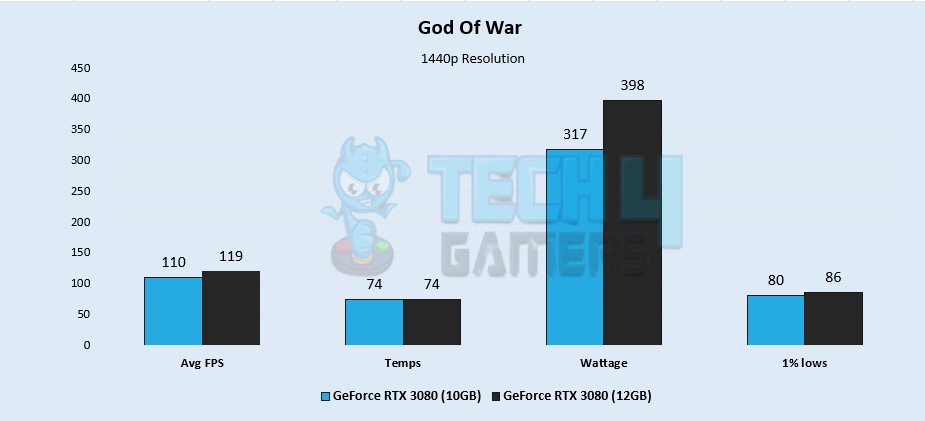
- At 1440p resolution while playing God of War, I saw the RTX 3080 10GB achieve an average of approximately 110 FPS, while the 12GB model delivered an average of 119 FPS, showcasing a performance advantage for the latter.
- In terms of temperatures, my benchmarks revealed both the RTX 3080 10GB and 12GB operated at 74°C.
- Power consumption varied, with the RTX 3080 10GB utilizing around 317W of power, ranging from a minimum of 313W to a maximum of 322W. In contrast, the 12GB model consumed approximately 398W of power, occasionally reaching 404W.
- Examining 1% lows, the RTX 3080 10GB maintained a minimum of 80 FPS, whereas the RTX 3080 12GB exhibited an average of 86 FPS as the lowest achieved FPS.
Check More: RTX 3080 Vs RX 6800 XT
Far Cry 6
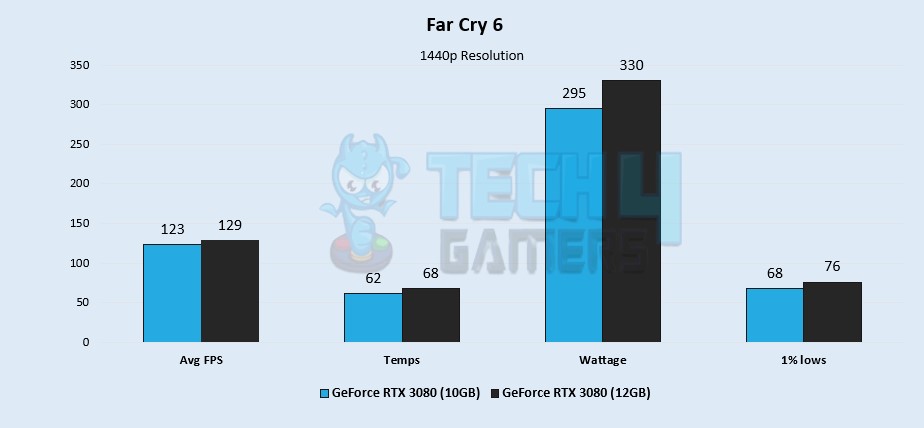
- Starting off, the RTX 3080 10GB averaged 123 FPS, while the RTX 3080 12GB delivered a slightly higher average of 129 FPS.
- In terms of temperatures, the RTX 3080 10GB impressively averaged 62°C. Meanwhile, the 12GB variant averaged 68°C.
- Regarding power consumption, I found that the RTX 3080 10GB consumed approximately 295W, occasionally reaching 305W. In contrast, the RTX 3080 12GB consumed 30W more on average, hovering around 330W.
- Examining 1% lows during my testings, the RTX 3080 10GB occasionally dropped to 68 FPS but mostly maintained around 80 FPS. Conversely, the 12GB variant mostly stayed above 80 FPS but occasionally dipped to 76 FPS.
PUBG
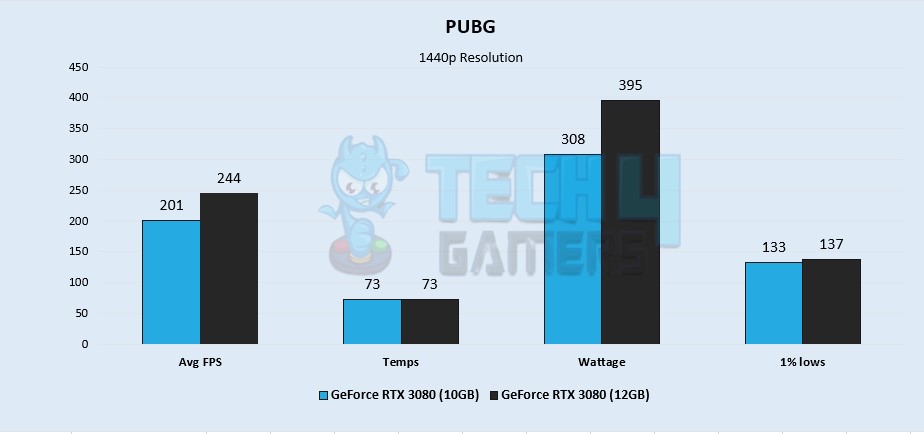
- Again showing a similar picture to my previous benchmarks, the RTX 3080 10GB achieved an average of 201 FPS, showcasing consistency with fewer fluctuations in FPS. In contrast, the RTX 3080 12GB exceeded expectations, averaging about 224 FPS and delivering over 20 FPS more than the 10GB model.
- Surprisingly, both graphics cards exhibited almost identical temperatures of 73°C at 1440p, with the 12GB model maintaining only a 1°C variation.
- In the realm of power consumption, my tests revealed that the RTX 3080 10GB averaged around 308W, fluctuating between 302W and 314W. In contrast, the power-hungry 12GB RTX 3080 consumed about 395W on average, resulting in an over 85W difference when comparing the two GPUs’ performance.
- In terms of 1% low FPS, I saw a close battle. The RTX 3080 10GB hit a minimum of 133 FPS. The 12GB RTX 3080 achieved a minimum of approximately 137 FPS.
Also Read: RX 5700 XT Vs RTX 3080
Overall Gaming Performance
Since all the benchmark tests of my RTX, 3080 10GB vs RTX 3080 12GB benchmarks are out of the way. It is time to conclude the results by comparing the two GPUs in their performance by portraying a graph that showcases each of their areas. This provides you with clarity as to which card is better in what field.
Average Framerates
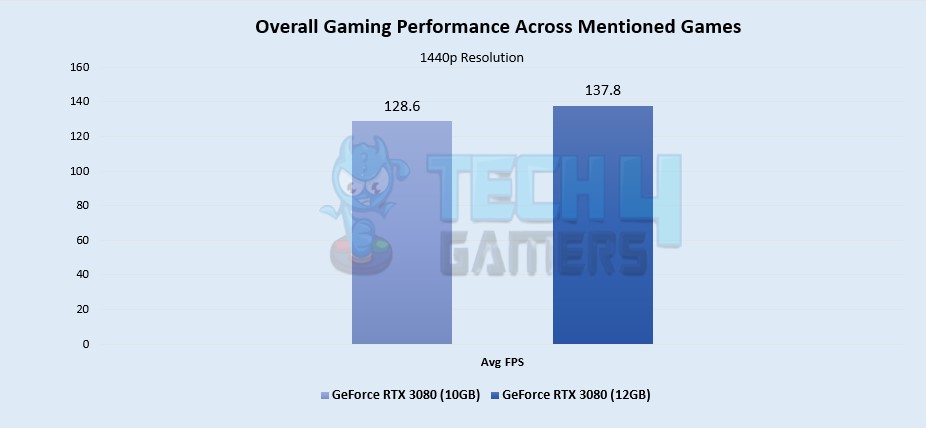
- Beginning with the average FPS, the RTX 3080 10GB averaged 128.6 FPS, whereas the RTX 3080 12GB achieved an average of 137.8 FPS.
- This performance disparity resulted in a 6.9% difference in FPS performance between these two competitors.
Similar Comparisons: RX 6700 XT Vs RTX 3080
Average Power Consumption
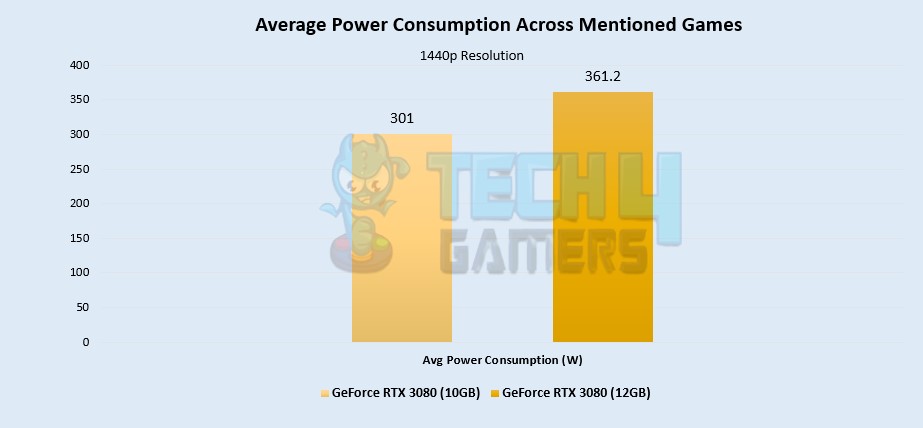
- Moving on to the average power consumption at 1440p, the RTX 3080 10GB exhibited an average power consumption of 301W, while the RTX 3080 12GB consumed an average of 361.2W.
- This disparity in power consumption translates to an 18.1% difference in power efficiency between the respective GPUs.
Also Check: RTX 4070 Ti Vs RTX 3080
Average Thermal Statistics
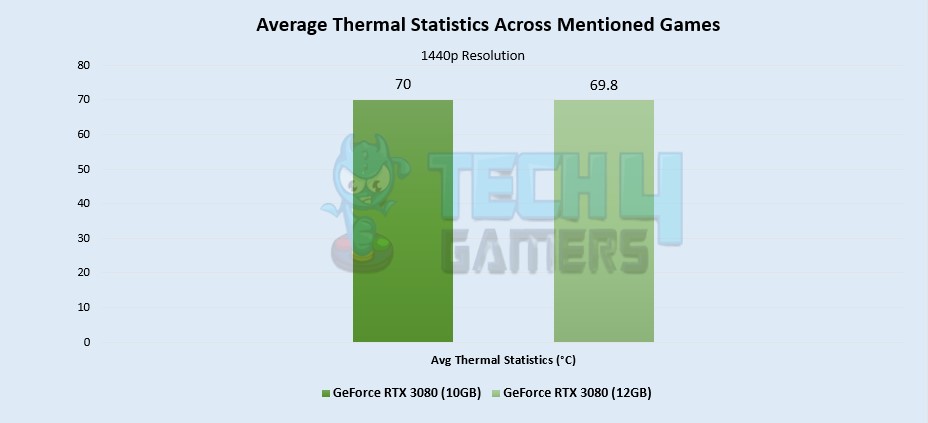
- Finally, going into the thermal statistics according to my tests, the RTX 3080 10GB maintained an average temperature of 70°C, whereas the RTX 3080 12GB averaged 69.8°C.
- This minor variation in temperatures results in a negligible 0.2% difference in thermal efficiency between the two cards.
Read More: RX 7900 XT Vs RTX 3080
RTX 3080 10GB Vs RTX 3080 12GB: Price And Availability
- According to my research in the market, the RTX 3080 10GB, released two years prior to the 12GB variant, received an updated V2 version without a hash rate limiter, benefiting cryptocurrency mining performance.
- Initially priced at $699 MSRP, the RTX 3080 10GB has experienced a significant price increase over time, with the cheapest cards now selling for slightly over $800 on Newegg.
- In contrast, the RTX 3080 12GB, while slightly more expensive than the 10GB variant in some cases, is available for approximately $1000 on Newegg.
RTX 3080 (10GB) Vs RTX 3080 (12GB): Which One Would I Recommend?
- If you prioritize gaming performance, I recommend the RTX 3080 12GB, which delivers a 6.9% higher average FPS at 1440p compared to the RTX 3080 10GB.
- For those concerned about power efficiency, the RTX 3080 10GB is the better choice, consuming 18.1% less power at 1440p.
- If thermal efficiency is your priority, both cards perform similarly, with only a negligible 0.2% temperature difference.
Also Check: RTX 4080 Vs RTX 3080
Pros And Cons
| GPU | Pros | Cons |
|---|---|---|
| GeForce RTX 3080 (10GB) |
|
|
| GeForce RTX 3080 (12GB) |
|
|
Thank you! Please share your positive feedback. 🔋
How could we improve this post? Please Help us. 😔
Feedback By:
[Comparisons Expert]
Abdemanaf is a skilled creative writer who has been honing his craft since 2011. While initially working in different fields, he found a passion for technology and has been exploring the tech world since early 2015. Over the years, he has developed an in-depth knowledge of the latest tech trends and product offerings by various companies.
Abdemanaf’s writing reflects his analytical mindset and ability to think critically. He has a knack for breaking down complex technical information into easily digestible pieces, making his articles engaging and accessible to readers from all backgrounds. In February 2022, he joined Tech4Gamers as a blog and product comparison writer, where he has been able to hone his skills further.
As a writer, Abdemanaf is dedicated to staying up-to-date with the latest technological advancements and trends, enabling him to provide readers with the most relevant and accurate information. He is always eager to learn more and is constantly seeking new challenges to improve his skills.
Get In Touch: manaf@tech4gamers.com


 Threads
Threads